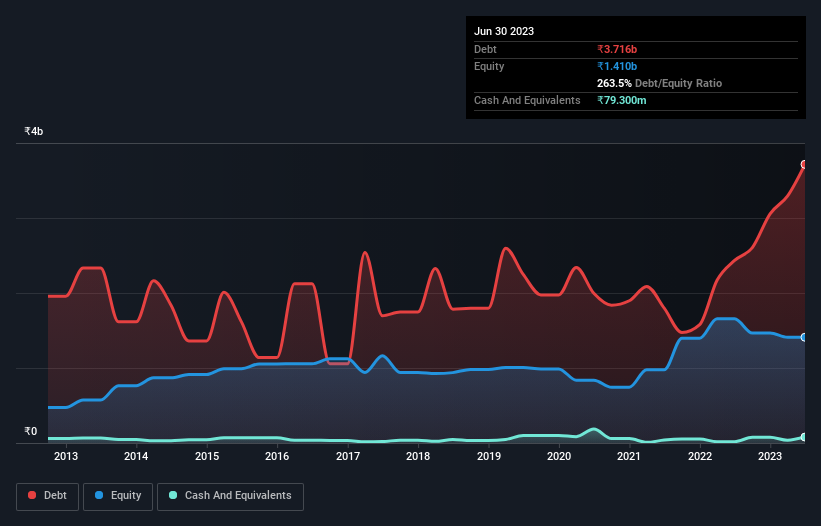Warren Buffett famously said, 'Volatility is far from synonymous with risk.' So it seems the smart money knows that debt - which is usually involved in bankruptcies - is a very important factor, when you assess how risky a company is. Importantly, Maral Overseas Limited (NSE:MARALOVER) does carry debt. But the real question is whether this debt is making the company risky.
When Is Debt A Problem?
Debt is a tool to help businesses grow, but if a business is incapable of paying off its lenders, then it exists at their mercy. If things get really bad, the lenders can take control of the business. However, a more usual (but still expensive) situation is where a company must dilute shareholders at a cheap share price simply to get debt under control. By replacing dilution, though, debt can be an extremely good tool for businesses that need capital to invest in growth at high rates of return. When we examine debt levels, we first consider both cash and debt levels, together.
Check out our latest analysis for Maral Overseas
What Is Maral Overseas's Debt?
As you can see below, at the end of March 2023, Maral Overseas had ₹3.72b of debt, up from ₹2.43b a year ago. Click the image for more detail. However, because it has a cash reserve of ₹79.3m, its net debt is less, at about ₹3.64b.

A Look At Maral Overseas' Liabilities
The latest balance sheet data shows that Maral Overseas had liabilities of ₹3.47b due within a year, and liabilities of ₹1.45b falling due after that. Offsetting this, it had ₹79.3m in cash and ₹1.46b in receivables that were due within 12 months. So its liabilities total ₹3.37b more than the combination of its cash and short-term receivables.
When you consider that this deficiency exceeds the company's ₹3.03b market capitalization, you might well be inclined to review the balance sheet intently. Hypothetically, extremely heavy dilution would be required if the company were forced to pay down its liabilities by raising capital at the current share price. There's no doubt that we learn most about debt from the balance sheet. But you can't view debt in total isolation; since Maral Overseas will need earnings to service that debt. So if you're keen to discover more about its earnings, it might be worth checking out this graph of its long term earnings trend.
In the last year Maral Overseas had a loss before interest and tax, and actually shrunk its revenue by 11%, to ₹9.9b. That's not what we would hope to see.
Caveat Emptor
While Maral Overseas's falling revenue is about as heartwarming as a wet blanket, arguably its earnings before interest and tax (EBIT) loss is even less appealing. To be specific the EBIT loss came in at ₹239m. When we look at that alongside the significant liabilities, we're not particularly confident about the company. We'd want to see some strong near-term improvements before getting too interested in the stock. Not least because it had negative free cash flow of ₹760m over the last twelve months. That means it's on the risky side of things. There's no doubt that we learn most about debt from the balance sheet. But ultimately, every company can contain risks that exist outside of the balance sheet. For instance, we've identified 3 warning signs for Maral Overseas (1 is potentially serious) you should be aware of.
If, after all that, you're more interested in a fast growing company with a rock-solid balance sheet, then check out our list of net cash growth stocks without delay.
New: Manage All Your Stock Portfolios in One Place
We've created the ultimate portfolio companion for stock investors, and it's free.
• Connect an unlimited number of Portfolios and see your total in one currency
• Be alerted to new Warning Signs or Risks via email or mobile
• Track the Fair Value of your stocks
Have feedback on this article? Concerned about the content? Get in touch with us directly. Alternatively, email editorial-team (at) simplywallst.com.
This article by Simply Wall St is general in nature. We provide commentary based on historical data and analyst forecasts only using an unbiased methodology and our articles are not intended to be financial advice. It does not constitute a recommendation to buy or sell any stock, and does not take account of your objectives, or your financial situation. We aim to bring you long-term focused analysis driven by fundamental data. Note that our analysis may not factor in the latest price-sensitive company announcements or qualitative material. Simply Wall St has no position in any stocks mentioned.
About NSEI:MARALOVER
Maral Overseas
Manufactures and sell yarns, fabrics, and garments in India, North America, Europe, Gulf and the Middle East, the Far East and South East Asia, Africa, and internationally.
Good value with low risk.
Similar Companies
Market Insights
Community Narratives




